When dogs hit their golden years, their bodies change in ways that really affect what they need to eat.
Senior dogs need carefully adjusted nutrition to support their aging bodies, keep a healthy weight, and manage health issues that come with age.
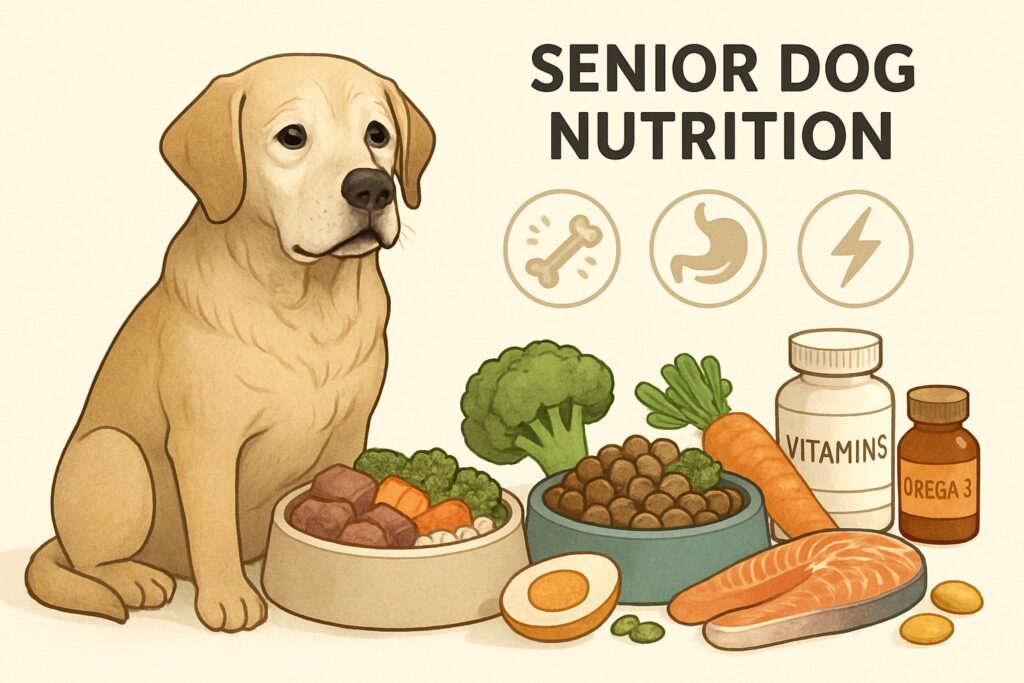
Table of Contents
Most pet parents don’t realize their senior dog needs different food until they see weight gain, less energy, or new health problems.
The right nutrition can add years to a dog’s life and make those years better. Even small changes in diet can make a big difference in how an older dog feels and acts.
This guide covers everything about feeding older dogs the right way.
You’ll learn which nutrients matter most, how to spot signs your dog’s diet needs a change, and practical tips for picking the best food.
We all want our senior dogs to stay healthy, happy, and active as long as possible, right?
Senior Dog Nutrition Guide – Key Takeaways
- Senior dogs need fewer calories but more nutrient-dense food to support their changing bodies
- Key nutrients like protein, omega fatty acids, and antioxidants become more important as dogs age
- Regular vet checkups help pet owners adjust their senior dog’s diet based on health conditions
Why Nutrition Changes As Dogs Age
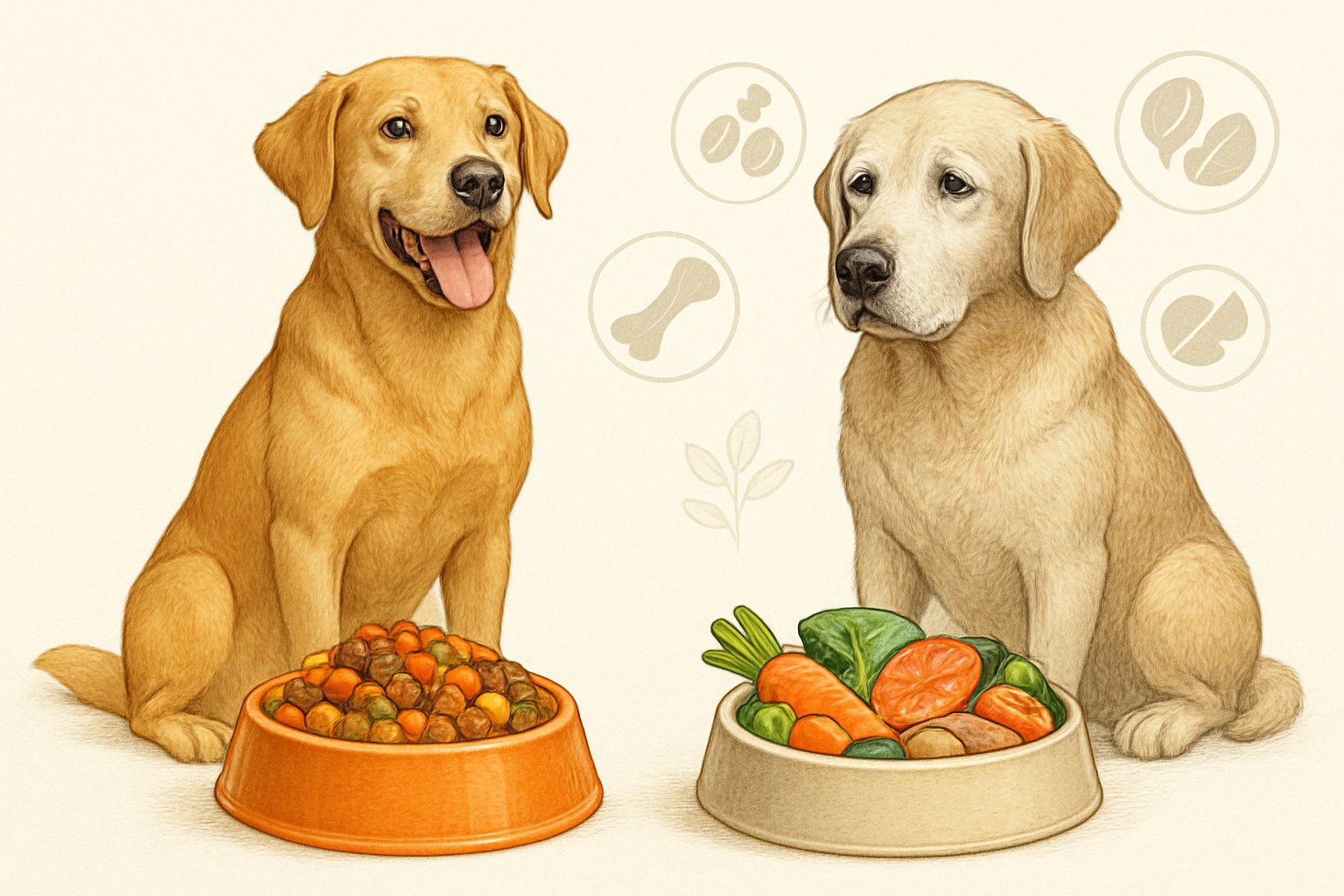
A dog’s body goes through big physical changes during the aging process. These changes directly affect how they process food and absorb nutrients.
Many people still believe old ideas about senior dog diets that can actually harm their aging companions.
How Senior Dogs’ Bodies Shift
When dogs get older, their metabolism slows down like a car shifting into a lower gear. They burn fewer calories, even if they still seem active.
The digestive system doesn’t work as smoothly. Their stomach makes less acid, so breaking down protein gets harder. Their intestines have a tougher time pulling vitamins and minerals from food.
Muscle mass drops around age 7 or 8 for most dogs. Without enough protein, muscle loss speeds up.
Senior dogs need high-quality protein to keep their strength up. Their kidneys and liver slow down, too. These organs filter toxins, but they can’t handle the same workload as before.
Picking the right food really matters now. Joint problems show up more often. Stiff, sore joints mean dogs move less, which burns even fewer calories.
Less movement leads to weight gain, which puts more stress on those sore joints.
Senior dogs also face higher risks of heart disease, cancer, and kidney problems. Their immune system weakens, so they get sick more easily.
Good nutrition becomes their first line of defense.
Common Misconceptions About Senior Dog Diets
One big myth says all senior dogs need “senior food” from the pet store. There’s actually no official rule for what makes food “senior.”
Some healthy older dogs do just fine on regular adult food. Many people think senior dogs need less protein, but that’s backwards. Older dogs actually need more high-quality protein to fight muscle loss.
Low-protein diets can make aging dogs weaker. Another false belief says senior dogs should eat less food overall. While they need fewer calories, they still need all the vitamins and minerals.
Just cutting portions can leave them short on nutrients. Some owners stop giving treats, thinking it’s healthier. Treats can fit into a balanced diet when you choose wisely. They also offer mental stimulation and bonding time.
Not all senior dogs are less active. Some older pups stay playful and energetic. Their food needs depend on their activity, not just their age.
Many people wait too long to change their dog’s diet. Nutrition needs can start changing as early as age 5-7 for bigger breeds.
Key Nutrients Every Senior Dog Needs
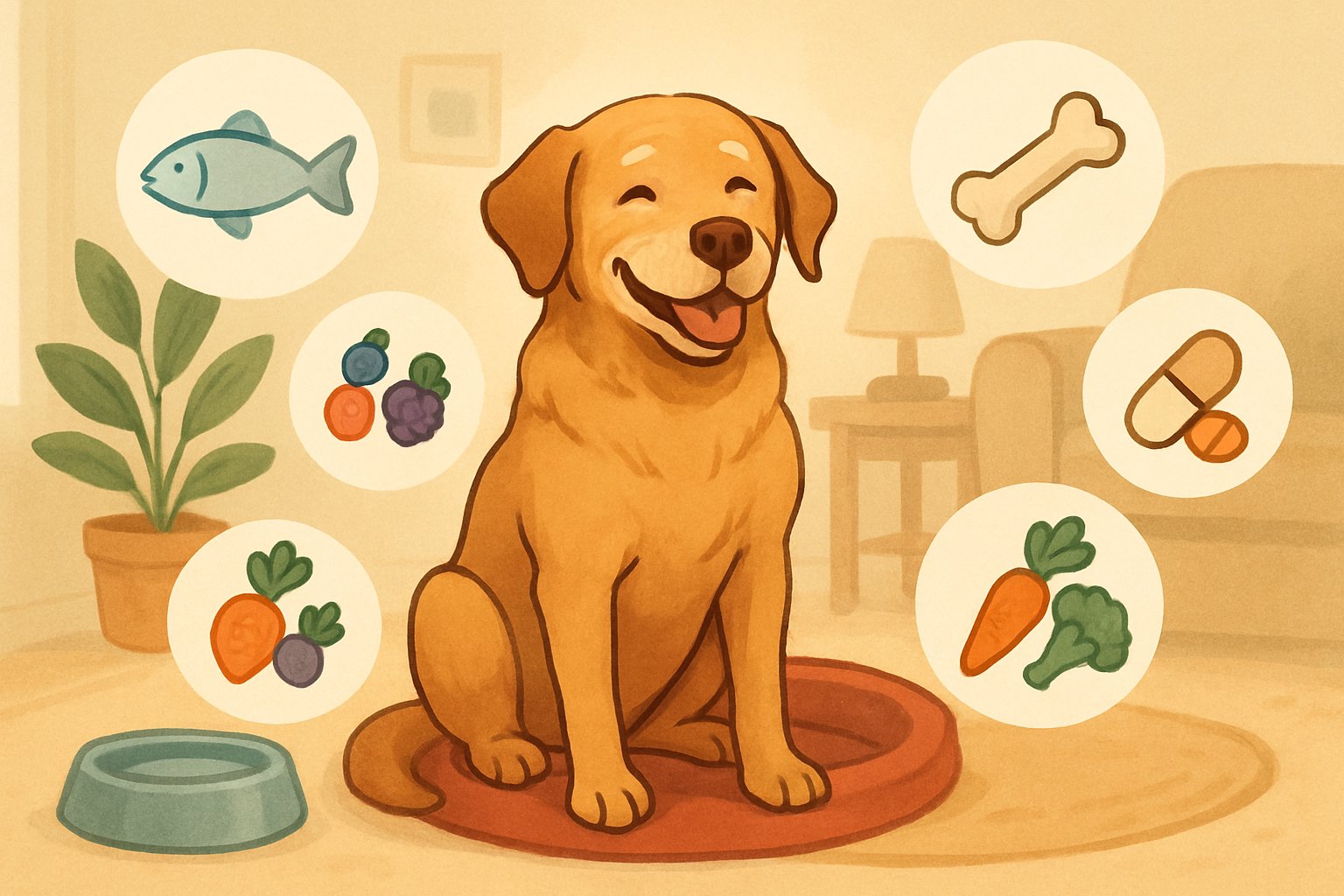
Senior dogs need specific nutrients to fight age-related issues like muscle loss, joint stiffness, and weaker immunity.
Quality protein, healthy fats, and the right vitamins make a real difference in their golden years.
Protein: The Muscle Protector
The pup who used to leap onto the couch might now struggle with stairs. Muscle loss hits senior dogs hard, so high-quality protein matters more than ever.
Senior dogs need at least 25% protein in their food. Not just any protein, though.
Low-quality fillers just don’t cut it. Look for chicken, fish, or lamb as the first ingredient. These proteins have all the amino acids older muscles need.
Here’s what quality protein does for senior dogs:
- Maintains muscle mass during natural aging
- Supports immune function through antibody production
- Aids tissue repair after daily wear and tear
- Keeps energy levels stable throughout the day
Some pet parents worry that too much protein hurts kidneys. That’s a myth for healthy senior dogs. Only dogs with kidney disease need protein restriction, and only if a vet says so.
The real problem is poor-quality protein sources.
Avoid foods that list “meat by-products” or “animal digest” near the top of the ingredients.
Healthy Fats For Shiny Coats And Brains
Ever notice how some senior dogs have dull coats while others still shine? It often comes down to the fat in their diet.
Omega-3 fatty acids are a game-changer for older dogs. EPA and DHA from fish oil help fight inflammation.
These fats bring real benefits:
- Reduce joint inflammation and stiffness
- Support brain function and memory
- Improve coat shine and skin health
- Boost immune system response
Look for foods with fish oil, flaxseed, or salmon as fat sources. Skip generic “animal fat”—it doesn’t offer much.
Medium-chain triglycerides (MCTs) from coconut oil can help too. They give senior dog brains quick energy.
Fat should make up 12-15% of a senior dog’s diet. Too little and you get dry skin and foggy brains. Too much and the pounds pile on.
Crucial Vitamins And Minerals
Senior dogs have it tough—they absorb nutrients poorly but need more of some vitamins and minerals.
Antioxidants matter a lot. Vitamins C and E help fight cell damage from free radicals. Blueberries, sweet potatoes, and spinach are great sources.
B-vitamins keep senior brains sharp. Thiamine, B6, and B12 help with nerve function and energy.
Key minerals for joint health:
- Glucosamine – helps rebuild cartilage
- Chondroitin – eases joint inflammation
- Calcium – keeps bones dense
- Phosphorus – supports bone structure
Fiber becomes more important. Senior dogs often get constipated. 3-5% crude fiber keeps things moving.
Prebiotics and probiotics help gut health. A healthy gut means better nutrient absorption and stronger immunity.
Many senior dog foods add these supplements. Check labels for guaranteed analysis—don’t just trust the marketing.
FAQs
1. How much protein should a senior dog eat daily? Senior dogs need at least 25% protein in their food. Healthy seniors can handle 30-35% protein just fine, unless a vet says otherwise.
2. Can I just add fish oil to my senior dog’s regular food? Yes, but start slow—about 1000mg per 30 pounds of body weight. Too much too soon can cause loose stools. Always pick fish oil made for dogs.
3. Do senior dogs really need special senior dog food? Not always. Many all-life-stage foods work for seniors. Just make sure protein levels are high enough and supplements like glucosamine are included.
4. What vitamins should I avoid giving my senior dog? Don’t give fat-soluble vitamins A, D, E, and K as supplements unless your vet says so. These can build up to toxic levels. Water-soluble B vitamins and C are usually safer.
5. How do I know if my senior dog is getting enough nutrients? Look for a shiny coat, steady energy, normal bowel movements, and good muscle tone. Yearly bloodwork helps catch deficiencies before symptoms show up.
Spotting Signs Your Dog’s Diet Needs A Tweak
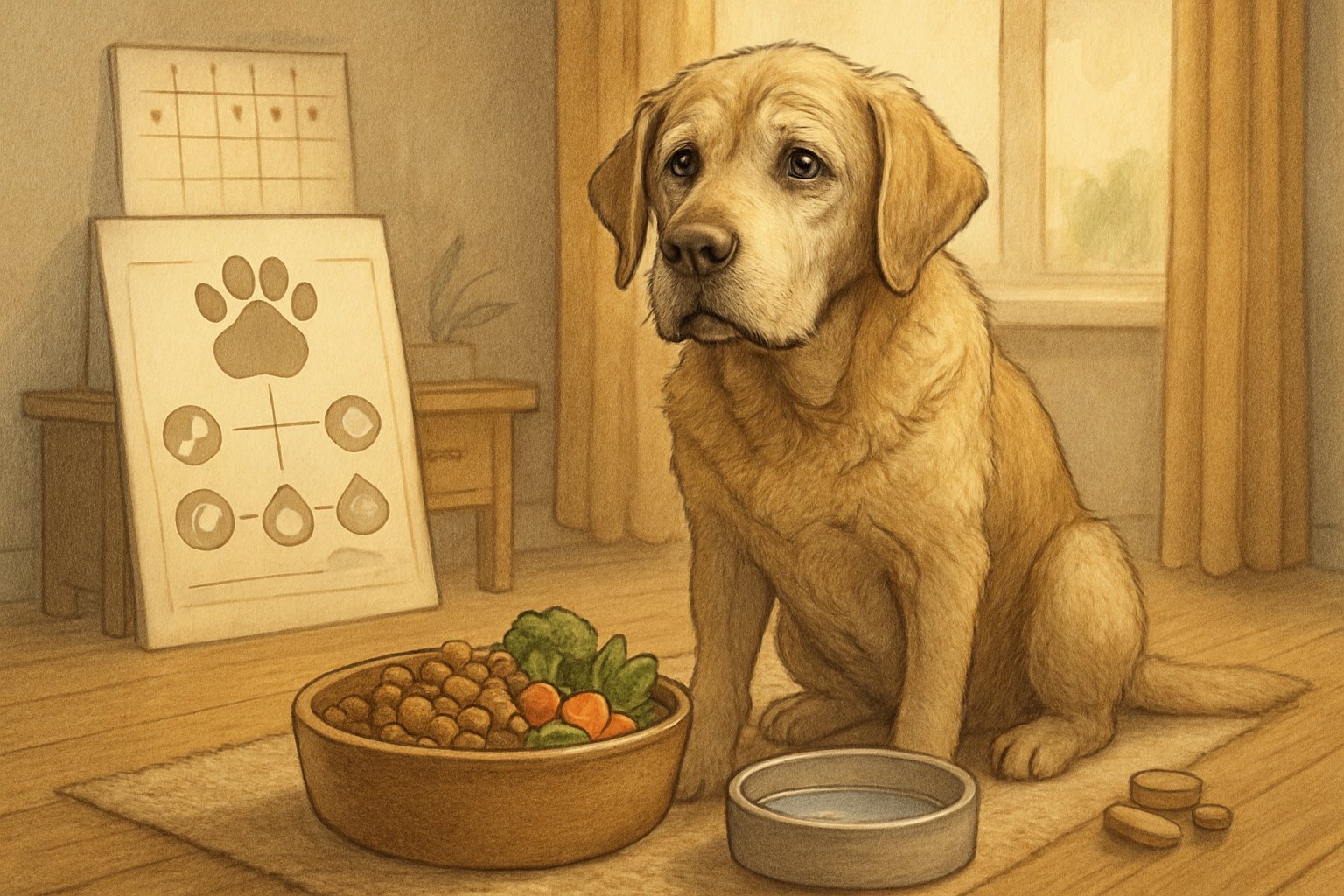
When a senior dog’s nutrition isn’t right, their body sends clear messages. You might see weight changes, tummy troubles, or weird eating habits.
Catching these signs early lets you make the right changes and keep your old friend happy and comfortable.
Weight Fluctuations And Energy Drops
Unexplained weight loss often means something’s off with a senior dog’s diet. If an older dog starts losing weight but eats the same amount, their food might not have enough calories or nutrients.
On the other hand, sudden weight gain usually means they’re getting too many calories for their slower metabolism. Senior dogs just don’t burn as much energy as they used to.
Energy crashes can be a red flag, too. If your dog used to love morning walks but now struggles to get up, maybe they need more protein or better ingredients.
Watch for these changes:
- Visible ribs or hip bones (weight loss)
- Hard to feel ribs under a layer of fat (weight gain)
- Sleeping more than 14-16 hours a day
- Reluctance to climb stairs or jump on furniture
- Shorter walks or lots of stops during exercise
These shifts happen slowly. A lot of owners don’t notice until things get pretty obvious.
Digestive Changes To Watch Out For
Senior dogs’ digestive systems just don’t work like they used to. Their stomachs make less acid, and their intestines don’t soak up nutrients as well anymore.
Frequent loose stools or diarrhea? Usually, that’s a sign their food is too rich or packed with stuff their aging belly can’t handle. High-fat foods often cause this mess.
Chronic constipation points the other way. Older dogs need extra fiber to keep things moving, but most regular dog foods fall short.
Excessive gas isn’t just annoying—it’s a clue their gut bacteria are having trouble. This shows up a lot with foods heavy in grains or low-quality proteins.
Vomiting undigested food hours after a meal? Their stomach’s probably struggling to process what they eat. Smaller, more frequent meals with easy-to-digest ingredients usually help.
Other digestive red flags can sneak up on you:
- Eating grass more often
- Gulping water after meals
- Bad breath getting worse
- Straining during bathroom breaks
Behavioral Clues From Picky Eating
Senior dogs get pickier with age, and for good reason. Their sense of smell fades, so food just isn’t as tempting, and dental pain makes chewing a chore.
Sniffing food but walking away usually means the smell isn’t strong enough to tempt them. Wet food or a splash of warm broth can do wonders here.
Eating around kibble pieces tells you certain textures hurt their mouth. Maybe it’s time for softer food or smaller kibble.
Begging for human food while ignoring their bowl? They’re probably bored with their current diet or not getting enough protein or flavor.
Dramatic appetite swings from one day to the next could mean something deeper is going on, sometimes diet-related, sometimes not.
Keep an eye out for these eating changes:
- Taking longer to finish meals
- Leaving food in the bowl for hours
- Hiding treats instead of eating them right away
- Drinking lots of water after eating dry food
- Whimpering while chewing
These aren’t just random quirks—they’re your dog’s way of telling you something’s up. The trick is to notice and respond before little problems turn big.
Choosing The Right Food: Wet, Dry, Or Fresh?
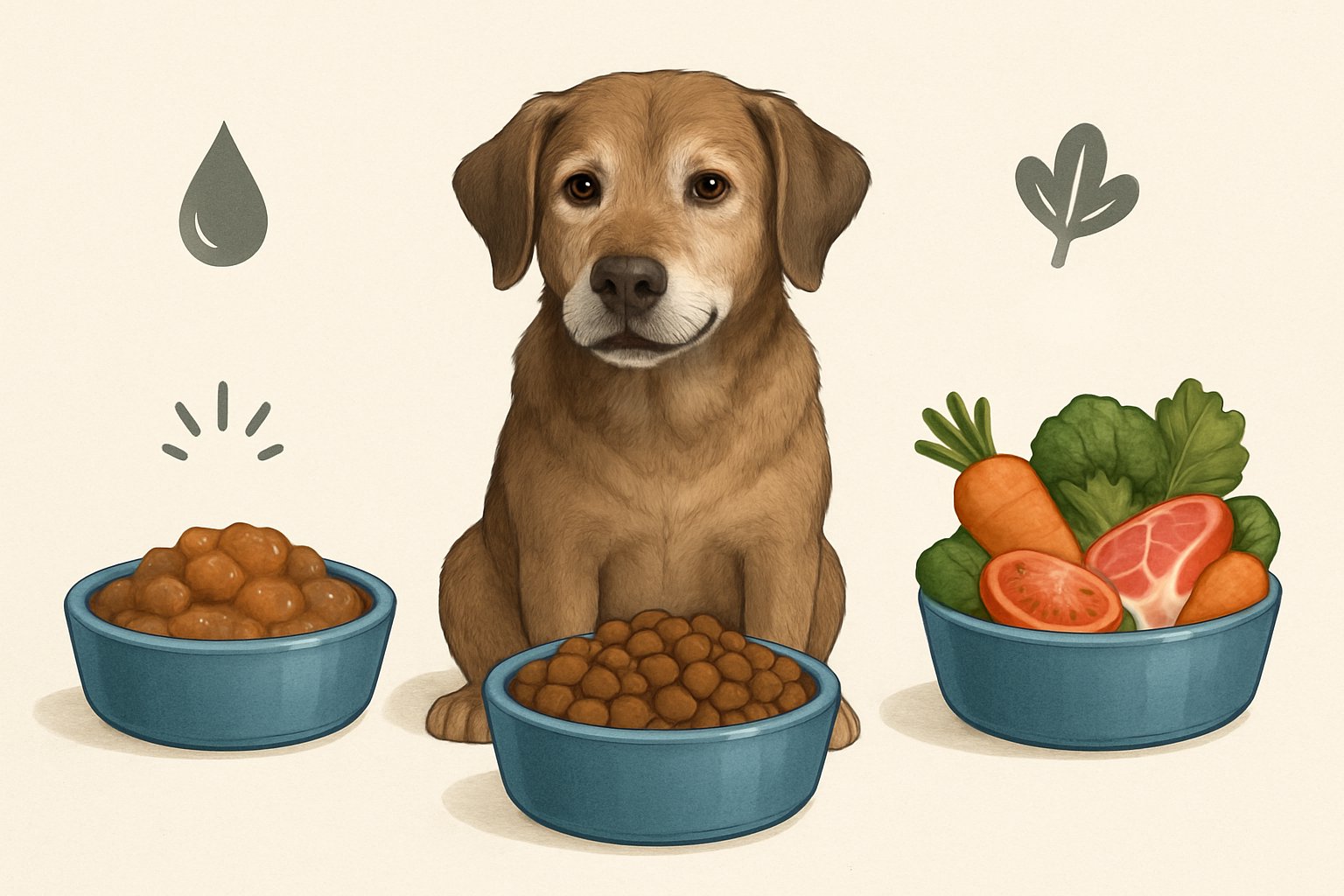
Senior dogs have their own preferences for food texture and moisture. Dental issues and appetite changes can make a big difference. Commercial diets are convenient and balanced, while homemade meals let you pick every ingredient.
Comparing Commercial Diets For Older Dogs
Wet food wins for hydration and appetite. Older dogs often drink less, so wet food’s moisture really helps. The soft texture is a lifesaver for dogs with sore teeth or gums.
Wet food also smells stronger than dry kibble. That’s huge when your dog loses some sense of smell and starts getting picky.
Dry kibble brings convenience and cost savings. It lasts longer and is easier on the wallet. Some seniors still love the crunch, especially if their teeth are in good shape.
The catch? Dry food packs more calories per cup. Older dogs with slower metabolisms can put on weight fast if you’re not careful.
Fresh commercial diets split the difference. These refrigerated foods have whole ingredients and save you time. They land somewhere between wet and dry in terms of moisture.
| Food Type | Moisture Content | Cost | Storage | Best For |
|---|---|---|---|---|
| Wet | 70-80% | High | Refrigerate after opening | Dehydrated or picky eaters |
| Dry | 8-12% | Low | Room temperature | Dogs with healthy teeth |
| Fresh | 60-70% | Highest | Always refrigerated | Active seniors |
Lots of people mix wet and dry food. That way, you get variety without blowing your budget.
The Truth About Homemade Senior Meals
Homemade meals let owners control every ingredient. This matters a ton for seniors with food allergies or kidney problems. Fresh ingredients also skip the preservatives in some commercial brands.
But cooking for your dog isn’t as simple as it sounds. Dogs need pretty specific protein, fat, and carb ratios, plus vitamins and minerals you won’t find in basic ingredients.
The biggest risk is nutritional imbalance. Homemade diets often miss key nutrients like calcium or go overboard on phosphorus, which can make kidney issues worse.
Meal prep takes significant time and money. Good ingredients cost more, and prepping meals every week is a real commitment.
Some older dogs get digestive upset when you switch to homemade. Their bodies get used to processed food after years on kibble.
Working with a veterinary nutritionist prevents problems. These pros can design recipes tailored to your dog’s health and recommend supplements to fill the gaps.
Raw diets come with extra risks. Senior dogs don’t fight off foodborne bacteria like they used to.
And, of course, stuff like onions, grapes, and chocolate are still toxic. Homemade plans have to avoid all dangerous foods, no exceptions.
Reading Labels: Decoding What Matters
Senior dogs need different nutrients than younger pups, but pet food labels can be confusing. The ingredient list tells the real story, even if the packaging tries to distract you with shiny claims.
Ingredient Lists: Friend Or Foe?
The ingredient list is where you find the truth. Ingredients are listed by weight, so the first five make up most of what’s in the bag.
Look for these at the top:
- Named proteins (chicken, salmon, beef)
- Whole grains or veggies
- Healthy fats like chicken fat or fish oil
Red flags to avoid:
- Vague stuff like “meat meal” or “poultry by-product”
- Lots of fillers like corn gluten meal
- Chemical preservatives (BHA, BHT, ethoxyquin)
Older dogs really do need more protein to keep muscle. If you don’t see a real protein source first, move on.
Watch out for ingredient splitting—companies might sneak in lots of corn by breaking it into “corn,” “corn gluten,” and “corn meal.” Added up, it’s often the main ingredient.
There’s also a difference between “chicken meal” and “chicken.” Meal is concentrated protein, while fresh chicken is mostly water and weighs more but gives less actual protein.
Marketing Hype Vs. Real Benefits
Packaging is all about selling, not informing. Words like “premium,” “holistic,” and “natural” sound good but don’t mean much legally.
Watch out for these marketing tricks:
- “Made with real chicken”—sometimes that’s just 3%
- Pictures of colorful veggies (dogs don’t care about rainbow kibble)
- “Vet recommended”—could just mean one vet liked it once
The guaranteed analysis is what counts. Seniors need at least 18% protein, but 25% or higher is often better. Fat should sit around 8-15%, unless your vet says otherwise.
What actually helps:
- Joint support like glucosamine
- Omega-3s for brain health
- Antioxidants—think vitamin E and C
- Prebiotics and probiotics for digestion
The feeding guidelines on bags are just a starting point. Seniors usually need about 20% fewer calories than younger adults. Weight management gets more important as they slow down.
Don’t get swept up in the grain-free craze. Most older dogs handle grains just fine, and some grain-free diets have been linked to heart problems.
Feeding Schedules And Portion Control
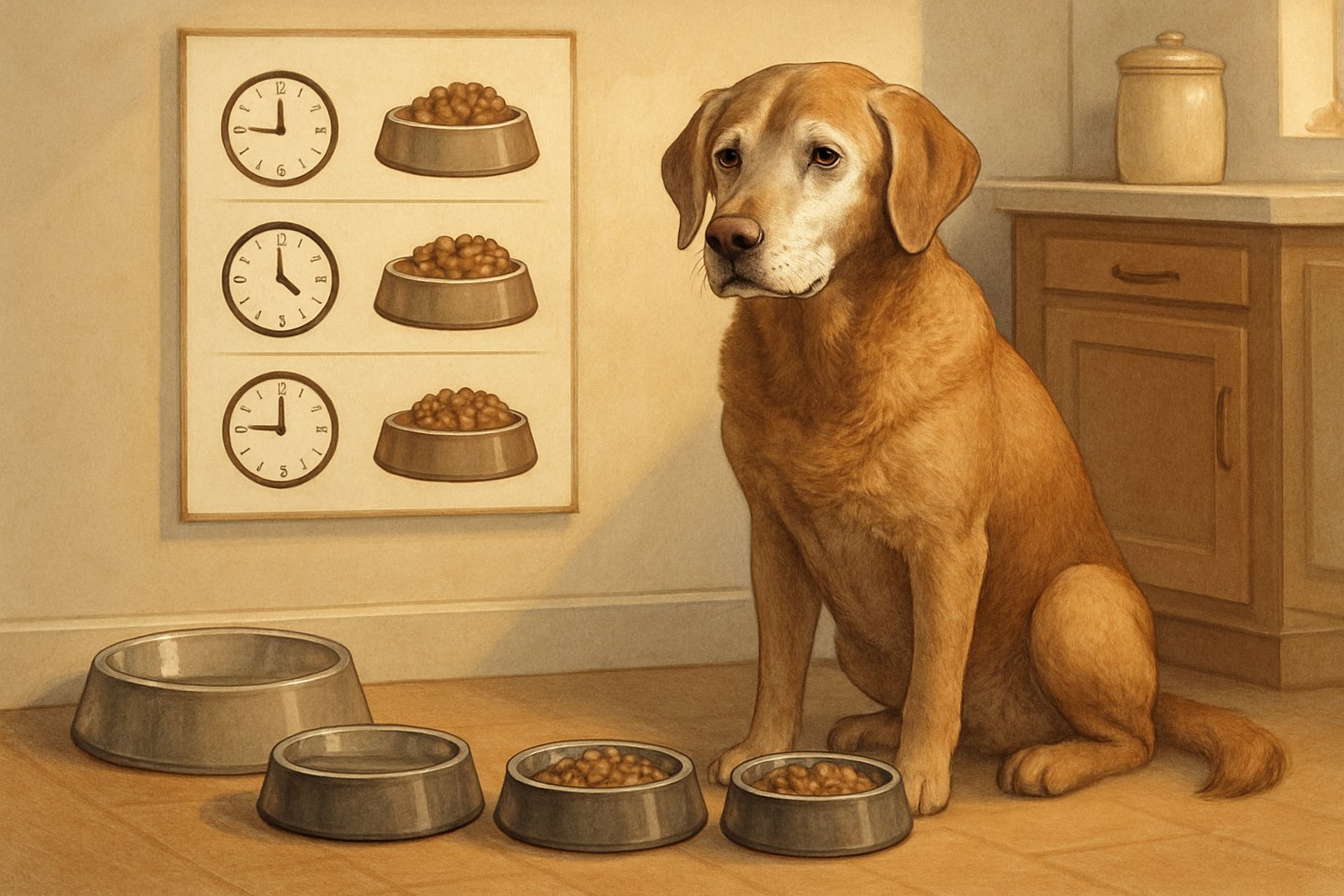
Senior dogs need different meal timing and portion sizes to stay healthy. Getting the schedule and portions right helps prevent weight gain and keeps their digestion on track.
How Often Should You Feed A Senior Dog?
Most older dogs do best with two meals per day spaced 8-12 hours apart. This gives their slower digestion time to work.
Some seniors need three smaller meals a day, especially if they have sensitive stomachs or get bloated easily.
If your dog has diabetes or other health issues, keep feeding times strict. These pups need to eat at the same times every day to help manage blood sugar.
Don’t free-feed senior dogs. Leaving food out makes it hard to track intake and can lead to overeating.
Dogs with kidney problems might need a special schedule. Always ask your vet what’s best if your dog has medical issues.
Portion Tips To Prevent Overfeeding
Senior dogs burn 20–30% fewer calories than adults, mostly because they’re less active. Lots of people don’t realize this and end up overfeeding.
Use a measuring cup to portion meals. Guessing with a bowl is almost always off.
Check your dog’s body condition every month. You should feel ribs without pressing hard, but not see them sticking out.
Split daily food into a few meals instead of dumping it all at once. This helps with digestion and stops them from scarfing everything down.
Treats shouldn’t be more than 10% of daily calories. Senior treats can be calorie bombs, so double-check labels before handing them out.
Consider a senior dog food formula. These usually have fewer calories but more of the nutrients older dogs need.
Supplements Worth Considering
Senior dogs deal with joint pain and slower recovery as the years creep up. Omega-3 supplements and joint support nutrients can honestly make a noticeable difference in how they move and act.
Joint Support For Older Dogs
Ever watch your old dog hesitate at the bottom of the stairs? Those stiff joints aren’t just “old age”—they’re begging for a little extra help.
Glucosamine and chondroitin act like tiny repair crews for cartilage that’s seen better days. These two help rebuild what years of chasing tennis balls have worn down.
MSM works as a gentle, natural anti-inflammatory. It’s like a pain reliever that doesn’t come with the chemical aftertaste.
Green Lipped Mussel throws a bunch of joint-supporting compounds into the mix. It’s kind of nature’s all-in-one formula for creaky knees.
Most dogs take about 6-8 weeks to show real improvement. If you start sooner, you’ll probably see better results.
Key Joint Support Options:
- Glucosamine (500-1000mg per 25lbs body weight)
- Chondroitin (400-800mg per 25lbs body weight)
- MSM (100-200mg per 25lbs body weight)
- Green Lipped Mussel extract
Vets usually suggest starting joint supplements around age 7 for bigger breeds. Smaller dogs can often wait until they’re 8 or even 10.
Omega-3s For Feel-Good Vibes
Notice how some old dogs stay sharp and happy while others seem foggy? Omega-3 fatty acids might be the not-so-secret reason.
These essential fats don’t just make coats shiny. They help fight inflammation all over and keep brains firing on all cylinders.
Fish oil delivers EPA and DHA—those are the omega-3s dogs need most. They help with joint comfort and memory, especially as dogs age.
Dogs can’t make omega-3s themselves. They need food or supplements to get what they need.
Try to find wild-caught fish oil instead of farmed. Wild fish usually have more omega-3s and fewer weird contaminants.
MCT oil gives aging brains a quick energy hit. These medium-chain triglycerides help brain cells perk up.
Start with tiny doses so you don’t upset your dog’s stomach. Most pups get used to it in a few days.
Daily Omega-3 Guidelines:
- 20-30mg EPA/DHA per pound of body weight
- Give with meals for better absorption
- Choose third-party tested products
- Refrigerate after opening
Managing Chronic Health Conditions Through Diet
Senior dogs with arthritis do better with anti-inflammatory foods. Dogs with kidney issues need less phosphorus and controlled protein. Sensitive stomachs call for gentle, easy-to-digest ingredients.
Adjusting For Arthritis And Mobility Issues
Watching a senior dog struggle to stand up is tough. Arthritis really messes with their daily life.
Omega-3 fatty acids help fight inflammation. Fish oil or salmon-based foods can shrink joint swelling and get dogs moving again.
Glucosamine and chondroitin support cartilage. You’ll find them in lots of senior dog foods, working to rebuild what arthritis breaks down.
Weight management makes a huge difference. Even losing a single pound can help a small dog walk easier. Extra weight just adds to joint pain.
Anti-inflammatory foods include:
- Blueberries (natural antioxidants)
- Sweet potatoes (vitamin C for cartilage)
- Turmeric (reduces swelling)
- Green-lipped mussels (joint support)
Try to avoid foods with corn or wheat. Some dogs really do better when you cut those out.
Tailoring Nutrition For Kidney Concerns
Kidney disease sneaks up on older dogs. Changing their food early can slow things down and help them feel better longer.
Reduced phosphorus keeps weak kidneys from working overtime. Look for foods with 0.5% phosphorus or less. Most regular dog food has way too much phosphorus for dogs with kidney trouble.
Protein quality matters more than just cutting back. Eggs and fish offer better protein than meat by-products, and they don’t make kidneys work as hard.
More water helps flush out toxins. Wet food is great for this, or just add warm water to dry kibble.
Essential kidney diet features:
- Lower sodium (helps blood pressure)
- Restricted protein (gives kidneys a break)
- Extra omega-3s (supports kidney function)
- Added B vitamins (replaces what’s lost)
Prescription kidney diets work best if things get serious. Vets monitor blood work to see if the diet’s helping.
Food Swaps For Sensitive Tummies
Older dogs often get sensitive stomachs. Swapping out ingredients can prevent those miserable tummy episodes.
Single protein sources make it easier to spot food triggers. If chicken’s a problem, try lamb or fish. Sometimes, even duck works for dogs with lots of allergies.
Limited ingredient diets keep things simple—one protein, one carb. They help you pin down exactly what’s causing the trouble.
Prebiotics and probiotics bring gut bacteria back in balance. Foods with chicory root or dried fermentation products are good for this.
Easy stomach-soothing ingredients:
- Rice (gentle carb)
- Pumpkin (fiber and enzymes)
- Bone broth (hydration and nutrients)
- Plain yogurt (good bacteria)
Feed smaller, more frequent meals. Three small meals a day works better than one big one for most seniors.
Skip artificial colors, preservatives, and fillers. Natural ingredients usually cause fewer stomach issues in sensitive dogs.
Common Mistakes To Dodge In Senior Dog Diets
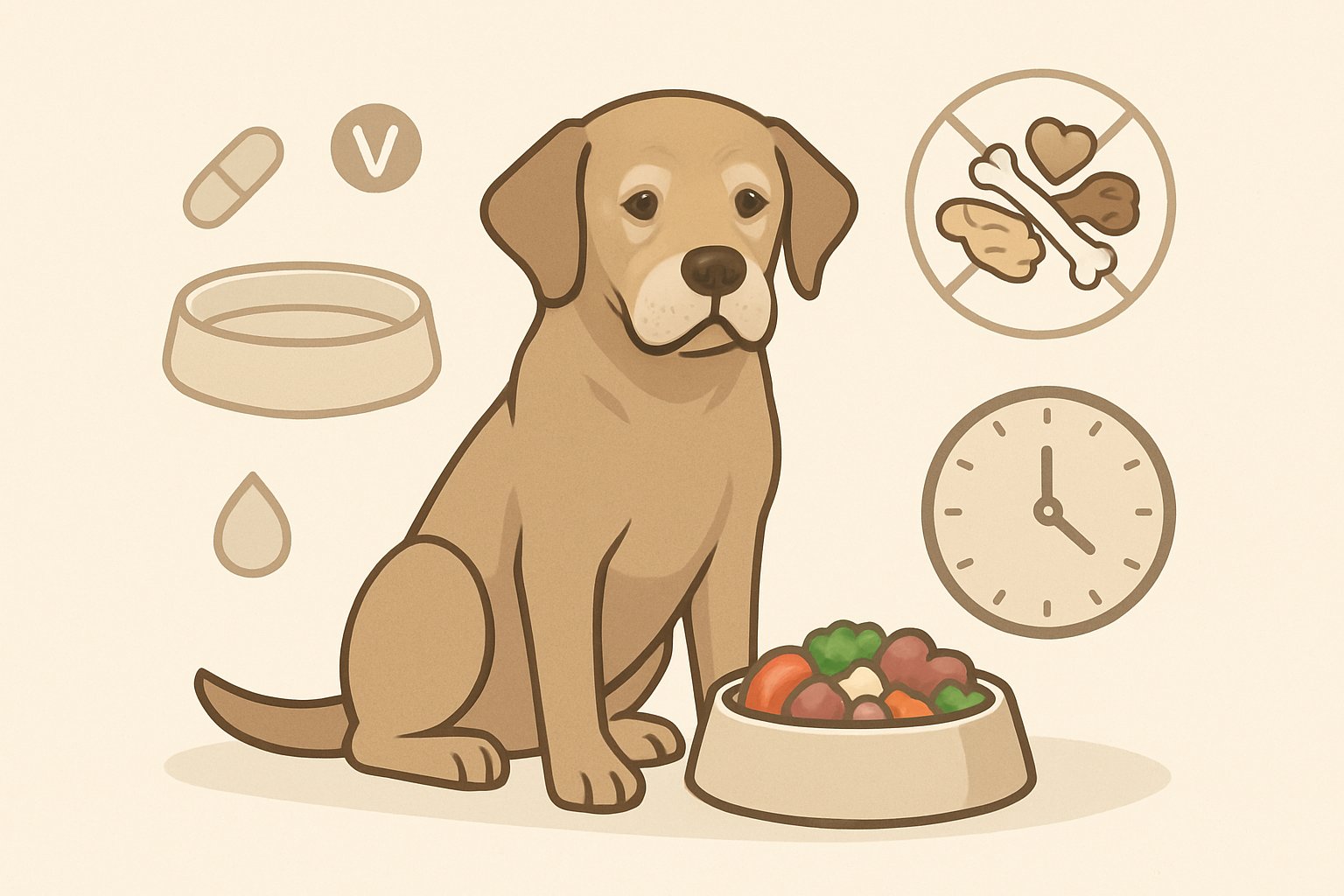
Ever watched your senior dog gain weight almost overnight? Lots of pet owners accidentally sabotage their older dog’s health with simple diet mistakes. These little errors can turn golden years into tough ones.
Overfeeding is probably the most common problem. Older dogs aren’t as active, but their bowls stay just as full. Before you know it, you’ve got an overweight pup with aching joints.
People often stick with the same rich kibble they used when their dog was young. Senior dogs need fewer calories and more focused nutrition. That high-protein puppy food is just too much at age 10.
Free-feeding becomes risky as dogs age. Older pups lose their natural portion control and will graze all day if you let them.
It’s easy to skip regular weight checks. But even a couple extra pounds can really stress an old dog’s joints and heart. “A little chub” isn’t as harmless as it looks.
Ignoring dental health with food choices can make every meal painful. Hard kibble is rough on sore gums and loose teeth, but owners keep pouring it out of habit.
Table scraps are another trap. Feeling sorry for an aging dog leads to more treats, but those fatty extras can upset digestion and add dangerous weight.
The biggest mistake? Skipping the vet when making diet changes. Every senior dog needs a nutrition plan that fits their changing body.
When To Consult Your Veterinarian About Nutrition
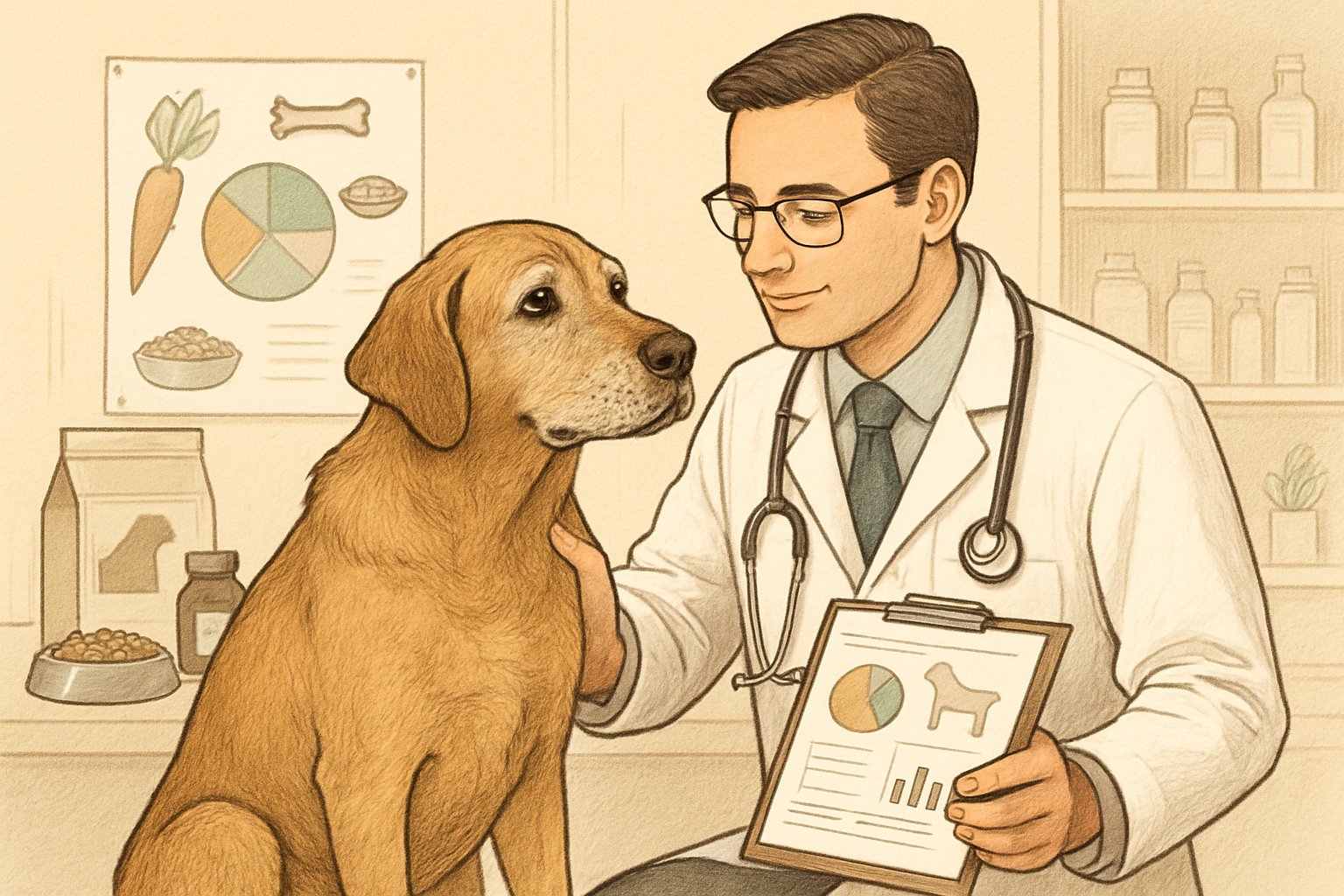
Think your senior dog’s stomach issues are just “old age”? Not so fast. Diet changes can sometimes fix way more than you’d expect.
Weight changes are a big warning sign. If your dog suddenly loses or gains weight without any diet changes, something’s up. Old dogs don’t bounce back from weight problems the way young ones do.
After age seven, two vet visits a year really matter. These checkups can catch issues before they spiral.
Watch for these warning signs:
• Eating less or skipping favorite foods
• Drinking a lot more water than usual
• Vomiting or diarrhea that sticks around
• New lumps or bumps anywhere
Joint pain often shows up as hesitation to jump or avoid stairs. Special diets with joint support might help, but only a vet can say if your dog needs prescription food or just a new supplement.
Kidney and liver problems sneak up on older dogs. Regular blood tests can catch them early. Some dogs need special diets with less protein to protect their organs.
Don’t just guess with supplements. Glucosamine could help, but it might not play nice with other meds. Always double-check.
Before switching to senior food, ask your vet: • Is my dog’s current food still working? • What health risks should I watch for? • Should I add any supplements?
Your vet knows your dog’s history better than anyone. They’ll spot diet and symptom connections that most of us would miss.
Simple Tips To Make Mealtimes More Enjoyable
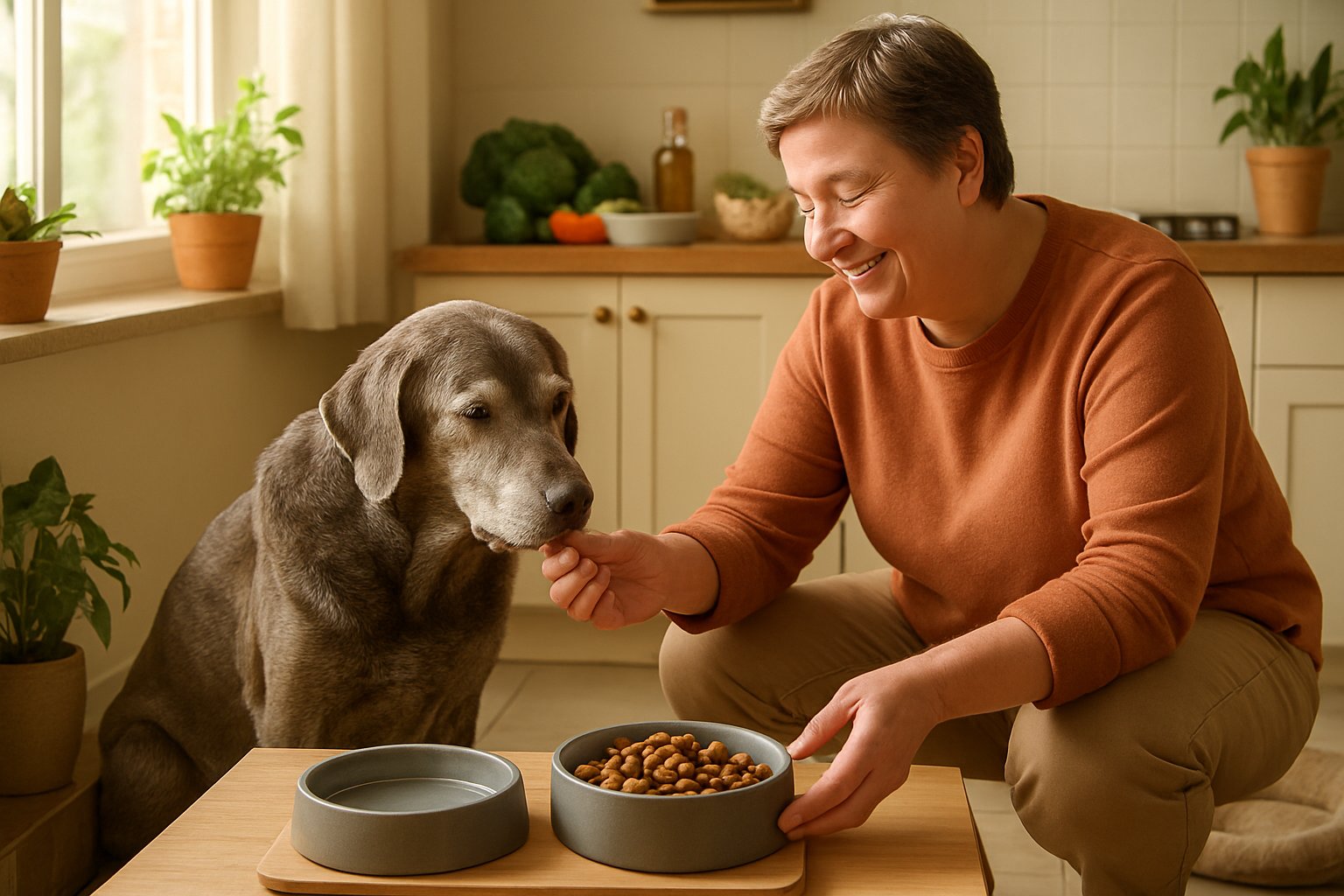
Is your senior dog turning up their nose at dinner lately? Making meals enjoyable for older pups can be surprisingly easy.
Lots of senior dogs lose their spark for eating as they get older. Naturally, this worries pet parents who want their furry friends to stay healthy and happy.
Warm up their food to bring out more aroma. Older dogs can’t always smell as well, so a little heat makes their meal more tempting.
Try hand-feeding small bites during training or just for fun. This builds positive vibes around food and gives their brain a little workout.
Mix up textures to keep things interesting:
- Add a spoonful of wet food to their dry kibble
- Toss in a few pieces of cooked chicken
- Pour in some bone broth for extra flavor
Create a calm eating spot away from loud noises and chaos. Most senior dogs love a quiet corner where they can focus on their meal.
Use puzzle feeders or snuffle mats to slow down speedy eaters. These tools make mealtime more fun and stop them from gulping too fast.
Split meals into smaller, more frequent servings. Three or four smaller meals usually sit better with older tummies than two big ones.
Add variety with vet-approved toppers like plain yogurt or pumpkin puree. These little extras can make regular food way more appealing.
Make it social by hanging out nearby while they eat. Some seniors just want their favorite human close at mealtime.
Stick to a schedule so they know when food is coming. Routine gives older dogs a sense of security and helps them look forward to eating.
Frequently Asked Questions
Senior dog nutrition can leave pet owners with a lot of questions. Here are some answers to common worries about feeding older dogs, from homemade meals to breed quirks.
Wondering what to toss in the bowl for your golden-aged pooch? Ever considered homemade meals?
Homemade meals can work for senior dogs, but you’ve got to plan carefully. A lot of folks assume chicken and rice covers all the bases, but that’s not the case.
The reality? Senior dogs need specific nutrient ratios that most homemade meals miss. They need at least 25 percent of their calories from protein, plus the right vitamins and minerals.
If you want to go homemade, talk with a veterinary nutritionist first. They’ll help you whip up balanced recipes that fit your dog’s changing needs.
Key ingredients to include: lean proteins like chicken or fish, sweet potatoes for fiber, and supplements for joint health. Skip garlic, onions, and too much fat—those can upset older stomachs.
If your vet had to choose the best chow for your senior tail-wagger, what would be on the menu?
Most veterinarians recommend prescription senior diets for dogs with health issues. These foods target common problems like kidney disease or arthritis.
Top vet picks include: Hill’s Prescription Diet for kidney support, Royal Canin Senior formulas for joint health, and Purina Pro Plan Veterinary Diets for weight management.
Vets usually suggest higher protein than regular adult food. Older dogs need more protein to keep their muscles strong.
The catch? Prescription diets need a vet’s approval and cost more than standard kibble. But plenty of seniors do well on high-quality over-the-counter foods if they’re generally healthy.
Let’s cut to the chase: which dog food brand is the cream of the crop for your aging fur baby?
Some brands always land at the top for senior dog nutrition. Ingredients and nutrient balance matter more than fancy labels, in my opinion.
Top contenders include: Blue Buffalo Life Protection Senior, Wellness Core Senior, and Orijen Senior. These brands pack in more protein and joint-friendly extras.
Each one’s got a slightly different vibe. Blue Buffalo leans into natural ingredients, while Orijen loads up on fresh meats.
The truth? The “best” brand depends on your dog’s needs, health, and honestly, your budget. What’s perfect for one senior might not work for another.
You know how your diet changes as you get older? How’s that any different for your lifelong canine companion?
Dogs deal with a lot of the same aging issues as us, but their nutrition needs shift in their own way. Their metabolism slows down and they don’t move as much.
Key changes include: they need fewer calories but more protein to keep muscles from wasting away. Unlike people, senior dogs often need extra protein as they age.
Their stomachs get a bit more sensitive, too. Foods that were fine before may suddenly cause upset or loose stools.
Joint issues pop up just like in people, so anti-inflammatory nutrients and omega-3s help. Dogs process these nutrients differently, so what works for us isn’t always right for them.
Time to talk about kibble: ever notice how some bags say ‘senior’? Here’s the deal—what makes them better for your old timer?
Senior-labeled kibble usually has tweaks for older dogs. These foods tend to have fewer calories so your less-active pup doesn’t pack on pounds.
Key differences include: more protein, added glucosamine for joints, and smaller pieces that are easier to chew. Omega-3s show up for brain and coat health, too.
They bump up the fiber to help digestion. Constipation’s a common complaint, so extra fiber keeps things moving.
However, not every “senior” label means better nutrition. Some brands just cut calories without adding the nutrients older dogs actually need.
Small pups, big hearts – got a tiny elder at home? Let’s find out what’s top-tier for their teeny tiny diets.
Small breed seniors have unique nutritional needs. They age differently than big dogs, and usually live longer too.
Timing matters: Small dogs under 20 pounds don’t need senior food until they’re about 10 or 11. Large breeds make the switch much earlier, around 6 or 7 years old.
Their tiny mouths do better with smaller kibble sizes. Many senior foods for small breeds use mini-kibble that’s just easier on aging teeth.
Higher calorie density is a plus for these little ones. Since they can’t eat much at once, they need nutrient-packed meals in smaller portions to keep their energy up without overfeeding.



Leave a Reply